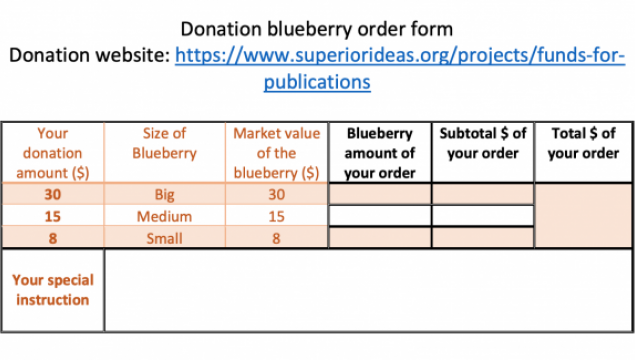Fund to cover undergraduates' publication cost
Why This Project Is Important
Publications from undergraduate students are extremely important in medical school and graduate applications. Along with a high GPA, a record of high-quality publications will improve undergraduate students’ chances to get into these postgraduate schools. Biological Sciences department at Michigan Tech offers senior undergraduate students a unique capstone experience by teaching courses like BL4510 and BL4530. These courses could help students to publish, for the first time, in real scientific journals. However, publications are generally not free in most national and international journals. On average, $2,000 is paid to the journals to publish a paper after peer review. We have about 10-15 senior undergraduate students who take BL4510 and BL4530 each semester. About 30% of these students' manuscripts can be accepted for publications after peer-reviewing processes conducted by the journals. By such calculation, they will require a minimum of $6,000 each semester for undergraduate student publications. The primary objective of this project is to raise sufficient funds to help undergraduate students publish their high-quality papers for their future career development. The completion of this project will place our undergraduate students in a better position in the national competition.
Project Description
This project is aimed to help our students excel in college undergraduate studies and to prepare them for medical schools, graduate schools, or working at various businesses. To fulfill this objective, we will revolutionize our senior capstone experience practice via BL4510/4530 courses. Every senior undergraduate student will be trained to publish a scientific paper in a real scientific journal by contacting editors of various specific journals with a pre-submission inquiry with students' topics of personal interests, contents, and key updated references. If successful, students will learn how to generate detailed outlines and draft their first version of manuscripts followed by revisions and submission of full manuscripts until successful acceptance of their manuscripts by the journals. Specifically, the students will be trained to have the following learning objectives in mind:
- The students will be able to contact specific journal editors with specific article titles, abstracts, and key references for pre-submission evaluation decisions;
- The students will be able to develop an outline of articles to draft the manuscripts;
- The students will be able to self-revise their manuscripts by self and peer/classmates/instructor reviews for submission;
- The students will be able to submit their manuscripts with key supporting data to specific journals for external expert review;
- The students will be able to finalize and proof-read their manuscripts for final publications following expert peer reviews;
- The students will be able to summarize and present their Capstone activities, experiences, and achievements.
Some unique highlights of the training:
1. Freedom of choice: Many topics could be of interest to students. The topics for their review writing will be their choice. As a senior student, you have been trained at Michigan Tech for a couple of years and must have developed certain interests and observations in science, education, social responsibilities, or even politics. There exist all kinds of journals, news, and book publishers to accommodate your articles. You will have full freedom in the choice of your topics and writings.
2. How to submit your presubmission inquiry: After drafting one page of your proposal with your intended article title (eye-catching), abstract (informative), and key references (recent and not older than 1 year) and peer review by your classmate peers' and instructor's comments and corrections you are ready to contact the editor of a specific journal for presubmission.
3. Strategy for the manuscript outline: By completing your pre-submission inquiry to the editor I am sure you have already some ideas to write about your proposed subject. In general, you can list your outline according to your proposed title and abstract. At least you can generate a table of glossary in which you will list all the glossary terms in your writing and give brief explanations. This will be the first step for you to start your outlines. However, a glossary table can be found in your textbook unless they are brand new. The next step will be to use these glossary terms to search PubMed or Google for the newest information related to those terms. Tons of information will appear by web search. Therefore, you have to limit the related information to the year 2020. If information is not enough then limit it to from 2019 to 2020. If still not enough limit to from 2018 to 2020, etc. By looking over the titles of the information you obtain do some classifications:
- What aspects of the information are related to your terms;
- What are their impacts in terms of citations;
- What are the breakthroughs in terms of public new reports;
- What are the latest progress of the related information you obtain. List the article titles of the above information and arrange their sequence logically (e.g. cause and effect, objective and outcome, etc). Relate all the titles with more summarizing, better wording, and your style so so to generate your outlines.
4. How to draft and revise the first version of your manuscript: Since your outline or subtitles are generated primarily from your key and new references it's essential to read them to your full understanding. In general, each time you read these papers more understanding and new ideas will be produced. Take notes to enhance your memory about them. Your ideas and insights are built upon them. Thus, your first version of the manuscript is made up of your keynotes along your outline. Since your outline is arranged in a logical way your first version of the manuscript will be similarly discussed logically. Your objective is to make sectional interaction along with your outlined manuscript and try to generate intriguing questions and novel insights based on the facts you collected. Once your first manuscript is generated you will be in a much better position to revise it to a new level. There are several approaches to improving your manuscript to a publishing level by asking the following questions:
- Is your manuscript arranged logically from basic concepts to the recent cutting-edge breakthrough? Read it aloud to see if it is up to your satisfaction.
- Do you have a list of concepts that are well defined? Make a glossary table with brief definitions as a key table for your manuscript.
- Are your manuscript references updated? Use the glossary to search for new relevant papers and read them for new concepts and progresses and cite them.
- Any new ideas and insights after the above processes? Write down any thoughts and imaginations by revising your manuscript in the above ways.
- Can you draw a figure to summarize your article or the key part of it? Draw a figure to help readers understand the essence of your manuscript instantly and clearly without the need of reading your manuscript. Add the figure with a clear legend to your manuscript.
Please note: Remember to revise your manuscript by answering one question of the above at a time so that you can have guidance to revise your manuscript at least five times. You can ask more questions about your revisions until you are totally satisfied. By doing the above processes, your manuscript is almost done and ready for starting internal peer review by classmates and instructors.
Meet the Researchers

Guiliang Tang
Dr. Tang conducted his graduate research on the catabolic pathway of the essential amino acid lysine in the laboratory of Dr. Gad Galili at the Weizmann Institute of Sciences, Israel. He then moved to the laboratory of Dr. Phillip D. Zamore at the University of Massachusetts Medical School for his post-doctoral research on plant RNA interference (RNAi) and microRNA (miRNA) pathways. He established his independent Gene Suppression Laboratory at the University of Kentucky (UK) and became a tenured Associate Professor there. In October 2011, he moved from UK to Michigan Technological University (MTU) at the Michigan’s Upper Peninsula (U. P.) for a family reunion and enjoyed the first winter time with much outdoor activities with his wife and kids. In May 2016, he became a full professor.

Eric Dobson
Completing a bachelor's degree in biology at Michigan Technological University. Attended Northern Michigan University for a bachelor's degree in mathematics years ago. I want to move into health data science or health informatics as a second career.


Cassidy Trotter
My name is Cassidy Trotter and I am a senior undergraduate student at Michigan Technological University. I am majoring in Biological Sciences and getting a minor in Psychology and Pre-Health Professionals.




days left
funded
last
What Your Donation Can Help Us Do:
- To cover the cost of undergraduate student publications in scientific journals. Donators can also join the online training courses BL4510/BL4530 for free.
$15 (1/100)
A healthy young blueberry bush in reward
Recent Donors
Some donors may be hidden.





 Gifts to projects listed on SUPERIORIDEAS.ORG are received and processed by Michigan Tech Fund. Michigan Tech Fund is a tax-exempt organization under Section 501(c)(3) of the Internal Revenue Code acting on behalf of Michigan Technological University. It is the policy of Michigan Tech Fund that a portion of the gifts and/or income therefrom may be used to defray the costs of raising and administering the funds.
Gifts to projects listed on SUPERIORIDEAS.ORG are received and processed by Michigan Tech Fund. Michigan Tech Fund is a tax-exempt organization under Section 501(c)(3) of the Internal Revenue Code acting on behalf of Michigan Technological University. It is the policy of Michigan Tech Fund that a portion of the gifts and/or income therefrom may be used to defray the costs of raising and administering the funds.